Photos and text by Joseph Sapia
Garden and Afield in Helmetta-Monroe-Jamesburg, 2016, May 22, Sunday, to May 28, Saturday
From my yard in the Helmetta Road area of Monroe and the surrounding Pine Barrens
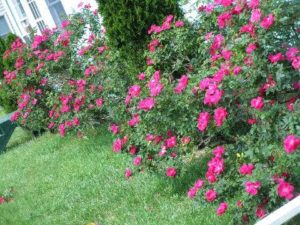
Knock-out roses
— “KNOCK OUT’ ROSES: The “Knock Out” roses are putting on a spectacular display, the best I recall since planting them in my yard in 2008.
— RACCOON/S AT THE BIRD-FEEDER: The battle continues between me and the raccoons at the bird-feeder. I have been putting the feeder in the garage at night, but the raccoon/s sometime beat me to the feeder.
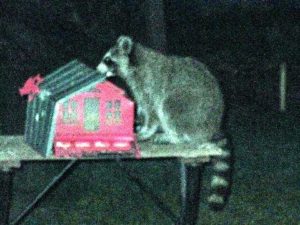
Raccoon at my backyard birdfeeder
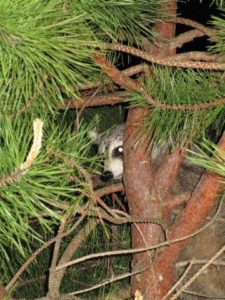
— CANADA GEESE GOSLINGS: Adult Canada geese are out and about with their goslings. The adults are amazing parents — and humans can learn from them, (Photo 6, at Helmetta Pond.)

Canada Geese at Helmetta Pond
— NEW JERSEY STATE BIRD AT THE FEEDER: An Eastern goldfinch at one of my bird-feeders. Easily identified as a male because of the bright colors.
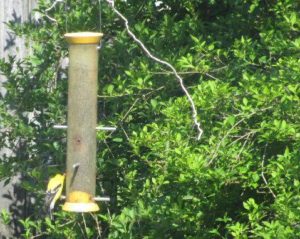
Eastern Goldfinch, the New Jersey state bird
— NORTHERN GRAY TREEFROGS: These called strongly during the week. See http://www.state.nj.us/dep/fgw/ensp/audio/no_gray_frog.wav.
— GARDEN: I planted May 21 and a week later plants were sprouting, most noticeable the Mammoth Gray-Stripe sunflower. Although I do not use fertilizer or pesticides, I water regularly. Once the plants get going, I water before 10 a.m. so as not to lose water to evaporation as the day warms.
— BLACK BEAR MOVEMENT: Reports continue about black bear sightings in Central Jersey and across the Delaware River in Pennsylvania. I am surprised there have not been more reports closer to home. If a bear is sighted, it is likely a 1-1/2-year-old male, perhaps 80 to 100 pounds, looking for its own turf. (What to do when encountering a bear, http://www.state.nj.us/dep/fgw/pdf/bear/bearfacts_know.pdf.)
— YARDWORK: I trimmed the shrubs, then started cutting the grass. I have to finish the lawncutting today. I still have to plant black-eyed Susans.
— BLAST FROM THE PAST, CIRCA LATE 1960S: Paul Migut with an 8-horsepower roto-tiller at his Uncle Stanley “Pon” Ceslowski’s garden on Old Road at Helmetta Road, Monroe. Over the years, Pon, Paul and Jim Becker worked that huge garden.

Paul Migut, circa late 1960s, at Pon’s garden
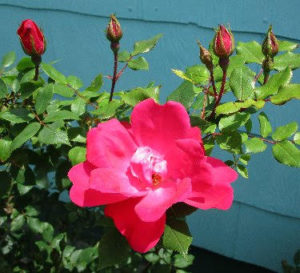
More knock-out roses
Joe Sapia, 59, is a vegetable gardener, who gardens the same backyard plot as did his Italian-American father, Joe Sr., and his Polish grandmother, Annie Poznanski Onda. Both are inspirations for his vegetable gardening. And he draws inspiration on the local Pine Barrens from his mother, Sophie Onda Sapia, who lived her whole life in the local Pines, and his grandmother.
The LRWP has submitted the following letter in response to NOAA’s Invitation to Public Comment on their “Restoration Plan/ Environmental Assessment Draft (RP/EA) for the American Cyanamid Co. Superfund Site, Bridgewater Township, Somerset County, New Jersey”:
May 23, 2016
Carl Alderson
NOAA Restoration Center – Sandy Hook Office
JJ Howard National Marine Fisheries Science Center
74 Magruder Rd, Highlands, NJ 07732
RE: American Cyanamid Draft RP/EA
Dear Mr. Alderson –
The Lower Raritan Watershed Partnership has reviewed NOAA’s proposed Restoration Plan/ Environmental Assessment (RP/EA) for the American Cyanamid Co. Superfund Site, Bridgewater Township, Somerset County, New Jersey and fully supports the proposal for primary and compensatory restoration activities.
The LRWP is New Jersey’s newest watershed association, formed in 2014 to address legacy contamination and current pollution in the Raritan River and the Lower Raritan Watershed. Our mission is to conserve, enhance and restore the natural resources of the New Jersey Watershed Management Area 9, the Lower Raritan Watershed. We believe that not only will removal of the Weston Mill Dam on the Millstone River directly improve resources impacted by legacy contamination, it is our understanding that the proposed project will benefit a broad spectrum of the Raritan River’s ecology and will likewise enable other environmental and human use benefits. Significant ecological, environmental and human use benefits have in fact already been realized following recent removal of a series of dams (Robert Street, Nevius Street and Calco) on the lower portion of the Raritan River between the towns of Bridgewater and Bound Brook. Likewise, we expect that design of technical fish passage at the Island Farm Weir (located on the Raritan River) will advance multiple Lower Raritan Watershed stakeholder goals.
The LRWP is also aware that the removal of the Weston Mill Dam on the Millstone River, as well as future modifications at the Island Farm Weir to include a technical fish passage at the Island Farm Weir on the Raritan River, will expand access to several thousand acres of non-tidal freshwater mid to upper reaches of the Raritan River’s major tributaries. Removal of Weston Mill Dam and the construction of a technical fish passage at Island Farm Weir will significantly enhance maturation and rearing habitat for striped bass, American shad, American eel, blueback herring, and alewife, and should significantly increase the abundance of anadromous and catadromous species, which will improve the ecological health of the Raritan River.
The LRWP’s only concerns with NOAA’s proposal are short term sediment transport impacts following dam removal. However, we are confident that NOAA’s plan to reduce potential environmental consequences is sound and further expect that the proposed projects will provide long term restorative benefits to water chemistry, specifically decreased water temperatures in formerly impounded sections, and increased dissolved oxygen concentrations. These changes will benefit riverine biota from the most basic food chain level up to the top predators for many years to come.
Enhancing fish populations in the Raritan River system is important for fresh and marine ecosystems. It is especially appropriate as the National Marine Fisheries Service (NMFS) lists the estuarine portion of the Raritan River as an important migratory pathway for anadromous alewife and blueback herring, species which NOAA lists as of special concern. The Lower Raritan Watershed Partnership feels that the proposed projects could help to reverse declining population trends, and anadromous fish returning to spawn each spring in the Raritan River provide an attraction to the general public in the Raritan River Basin. The removal of the Weston Mill Dam on the Millstone River and feasibility analysis and design of technical fish passage at the Island Farm Weir are important to the LRWP and we fully support the proposed projects.
Sincerely,
Heather Fenyk, Ph.D., AICP/PP
President, Lower Raritan Watershed Partnership
www.lowerraritanwatershed.org
The National Oceanic and Atmospheric Administration, the Department of Interior, and the State of New Jersey invite public comment on a proposed plan.
The Draft RP/EA is available at the following website:
http://darrp.noaa.gov/hazardous-waste/american-cyanamid
The public comment period on this plan ends June 10, 2016.
To request further information or an additional hard copy of this document or to submit your comments, please contact Carl Alderson at (732)371-0848, NOAA Restoration Center – Sandy Hook Office, JJ Howard National Marine Fisheries Science Center, 74 Magruder Rd, Highlands, NJ 07732 or by email at Carl.Alderson@noaa.gov. Please put “American Cyanamid Draft RP/EA” in the subject line.
Garden and Afield In Helmetta-Monroe-Jamesburg
2016, May 15, Sunday, to May 21, Saturday
by Joseph Sapia

Nearly a Full Corn-Planting Moon during the week
— NIGHT SKY: On Saturday, the moon turned full, the Full Corn-Planting Moon. Look for a bright red Mars for weeks. (The photograph is of the almost-full moon over Monroe and Jamesburg.)
— VEGETABLE GARDENING: I got the vegetable garden in on Saturday, May 21, working in and out of rain. I am a bit concerned I went by the calendar, using May 20 as my guide to when the soil normally would be warm enough to plant, rather than by this year’s still-cool weather. That is, the soil may still be too cool for the warm-season vegetable plants. Perhaps I should have waited to June 1. No matter if I went with my heart over my head, the crop is in: Mammoth Gray-Stripe Sunflower, Cuppa Joe Sweet Corn, Rutgers Tomato, Hale’s Best Jumbo Cantaloupe, Born-to-be-Mild Hybrid Hot Pepper, Kaleidoscope Mix Carrot, Northern X-tra-Sweet Hybrid Sweet Corn, Igloo Lettuce, Carnival Mix Sweet Pepper, and Tasty Green Cucumber.
— OLD SEEDS: The Mammoth Gray-Stripe Sunflower, Cuppa Joe Sweet Corn, and Tasty Green Cucumber are 2015 seeds, which still should produce a crop.
— HOW I SEED: For what it is worth, I do not single-seed. Instead, I place a few to a bunch of seeds per hole.
— POLLINATION IN THE VEGETABLE GARDEN: I am trying something new in the garden, adding flowers to attract pollinators. So, I threw around seeds of Burpee’s Bee and Butterfly Garden and Monmouth Conservation Foundation’s Project Pollinator/Kids for Conservation.
— GARDENING ZONES: As the area transitions from the cooler Zone 6 to the warmer Zone 7, because of global warming, we will have a longer growing season. The gardening downside, more erratic weather. For example, many days of rain, followed by long periods of droughty weather. And, of course, the environmental downside is the global warming.
— RACCOONS AT THE BIRD-FEEDER: I enjoy watching the nightly visit of a raccoon or raccoons at the bird-feeder, sometime joined by a skunk below the feeder. I guess the raccoons and skunk like the sunflower hearts/kernels I use – and they have to eat, too, while entertaining me. But I got tired of the raccoon/s knocking down the feeder night after night. So, for now, I am bringing the feeder inside the garage at night and putting it back out in the morning.
— BIRDS: House finches were flying around the yard, fluttering to trees, bird-feeder, and clothesline, having trouble landing. They must have been fledglings, trying to figure it all out.
— WHIP-POOR-WILL CALLING: About 10:45 to 11 p.m. Wednesday night, May 18, a whip-poor-will called loudly, if only sporadically. This was once a common bird here in the local Pine Barrens – calling ad nauseam through the overnight. But this one was the first I have heard in an estimated 6 years. I got reports of whip-poor-will calls from around my Helmetta Road neighborhood, so I hoping for a return of the whip-poor-will.
— MOUNTAIN LAURELS AND SNAPPING TURTLES: Mountain laurel should begin blooming about now. So, remember this bit of Pine Barrens lore: “The snapping turtle lays its eggs, when the mountain laurel blooms.” Watch for snappers crossing roads – probably a female headed to high ground from a swamp to lay eggs or a female returning to a swamp after laying her eggs on high ground. If helping the turtle along, move it in the direction it is traveling. I MOVE A SNAPPER ONLY WITH A SHOVEL, because here is more Piney lore to think about, “Only the setting sun or lightning makes the snapping turtle let go.” If bitten, try running a wire down its nostril to make it let go. (Moving a snapper by lifting it by its tail could hurt it – and, also, it could bite the mover and not let go….)
(Garden observations are from my yard in the Helmetta Road area. Pine Barrens observations are from the Helmetta-Monroe area Pines.)
Joe Sapia, 59, is a vegetable gardener, who gardens the same backyard plot as did his Italian-American father, Joe Sr., and his Polish grandmother, Annie Poznanski Onda. Both are inspirations for his vegetable gardening. And he draws inspiration on the local Pine Barrens from his mother, Sophie Onda Sapia, who lived her whole life in the local Pines, and his grandmother.
Article and photos by Joe Mish

This female red phase screech owl with erect ear tufts and large eyes looks as ferocious as it sometimes sounds.
The calm starlit night, made blacker by the dark phase of the moon, was the perfect setting for a peaceful night’s sleep. The windows were wide open and the air scented with honeysuckle as the gentle sounds of the night played a sleepy time lullaby.
Deep sleep and dreams were well under way when a primal scream, just outside the window, vibrated the walls. Everyone sat up, hearts beating wildly, sleeping coonhounds unleashing unheard of sounds that must have been reserved in the event they ever treed the devil.
Before my heart beat slowed, I figured the sounds had to come from a screech owl perched on a tree limb six feet from the bedroom window. The unearthly screams were one selection of screech owl vocalizations that include rapid clicking of its beak and a gentle wavering call that, through association with spooky movies can easily raise the hairs on the back of your neck.
The volume of a screech owls’ motivated scream is inconsistent with its small size. The eastern screech owl is about 9 inches tall, weighs around 6 ounces with a 24 inch wingspan and easily fits through a three inch nest box hole.
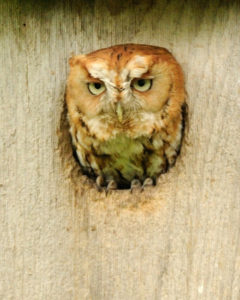
Adult red phase screech owl perches in 3″ hole of its nest box, note the feet gripping the edge of the opening.
Eastern screech owls come in two colors, a red phase and a gray phase. Its physical appearance, while perched, gives the impression it is missing the lower half of its body. During the day with its eyes shut it blends in so perfectly with its background it is difficult to tell what part is what. The owl seems to suddenly appear from the background when it opens its large yellow eyes.
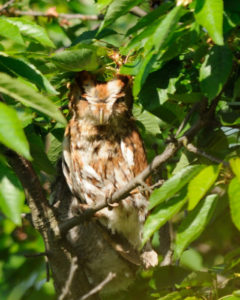
Eyes closed, these owls seems to disappear with no reference to top or bottom or recognizable form.
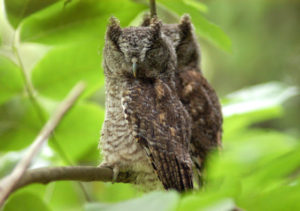
Screech owls seem to comfortably tolerate humans and can be seen, and will nest, in proximity to homes and buildings if a nest box is provided.
Late June early July, a screech owl would show up whenever I went into the backyard around dusk. It would follow me around and click its beak from a nearby branch. I have no idea what motivated that behavior but that owl provide plenty of photo opportunities.
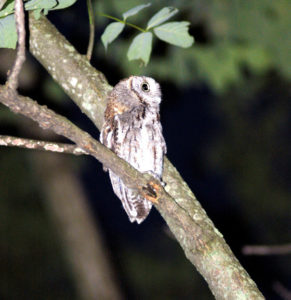
Then there were the memorable Christmas day visits. One Christmas morning I went to the open woodshed to replenish the woodstove with an armful of oak. There, staring me in the face from four feet away was a gray phase screech owl. It stayed put while I gathered the wood but was gone when I returned with my camera.
A few years later on Christmas night, a red phase screech owl perched a few feet off the ground in a weeping cherry tree. The little owl was spotted by the car’s headlights. It remained undisturbed while I did capture its image.
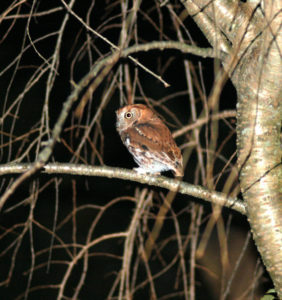
A late Christmas present in full feather, delivered at the front door.
Screech owls may just as well be found in deep woods. I have a great image of a red phase owl sitting in a healed hole in the side of a large tree trunk about eight feet off the ground. Other sightings have been in places where mature sycamore trees grow. Often, broken branches will leave a cavity that overtime becomes deeper, forming a perfect nest or day time resting place for this diminutive owl.
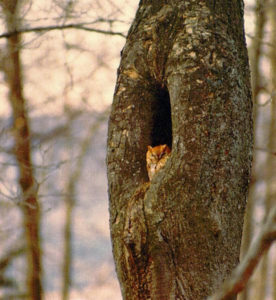
Though screech owls are quite common, you may never see one. Think of them as a night time radio host whose show you listen to all the time but never put a face to the voice. Hear a sampling of screech owl calls at: https://www.allaboutbirds.org/guide/Eastern_Screech-Owl/sounds
Author Joe Mish has been running wild in New Jersey since childhood when he found ways to escape his mother’s watchful eyes. He continues to trek the swamps, rivers and thickets seeking to share, with the residents and visitors, all of the state’s natural beauty hidden within full view. To read more of his writing and view more of his gorgeous photographs visit Winter Bear Rising, his wordpress blog. Joe’s series “Nature on the Raritan, Hidden in Plain View” runs monthly as part of the LRWP “Voices of the Watershed” series. Writing and photos used with permission from the author.
Our friend and “Voices of the Watershed: Pinelands of Helmetta” contributor Joe Sapia writes:
“Wow, I just heard a whip-poor-will calling at my house in the Helmetta Road area. That is the first time in about 6 years I have heard this bird, once a harbinger of spring in the local Pine Barrens, since about 2010.
Antrostomus vociferus is considered a jeopardized species in NJ. This one, I heard from about 10:45 p.m. to 11 p.m. Its call was powerful, meaning it was close, but it was sporadic, not the ad nauseam call.
Listen to an example and multiply that all night.
Around here, I would say this bird is a Pine Barrens bird, so it could be heard in parts of Monroe (north of Jamesburg and hugging the Old Bridge and Manalapan boundaries), anywhere in Helmetta and Spotswood, and other local Pine Barrens areas.
If you hear one locally, let me know when and the general location. Thanks.
A few weeks ago, I saw a brown thrasher, “Toxostoma rufum,” the first one I saw locally in years. What is going on?”
The Senate Environment and Energy Committee will meet on Monday, May 16th at 10am – the Committee has invited representatives from the NJ Department of Environmental Protection to discuss modifications to their proposed Flood Hazard Area Control Act Rules, Coastal Zone Management Rules, and the Stormwater Management Rules.
We encourage concerned stakeholders and citizens to come hear what NJDEP has to say about the changes they plan to make to their proposed revisions of the Flood Hazard rules.
WHEN: Mon., May 16th @ 10:00am
WHERE: State House Annex
125 W. State Street, Trenton NJ
Committee Room 10, 3rd Floor
Received today from Carl Alderson, NOAA Federal
To All Interested Government Agencies and Public Groups:
Under the National Environmental Policy Act, an environmental review has been performed on the following action.
TITLE: Restoration Plan/ Environmental Assessment Draft (RP/EA) for the American Cyanamid Co. Superfund Site, Bridgewater Township, Somerset County, New Jersey
LOCATION: The Millstone and Raritan Rivers, Somerset and Middlesex Counties, New Jersey.
SUMMARY: The National Oceanic and Atmospheric Administration (NOAA) is the lead federal agency for National Environmental Policy Act (NEPA) compliance for projects brought forth to restore injured habitat for fish and other trust resources resulting from long-term hazardous substance releases from the American Cyanamid Co. Superfund Site in Bridgewater Township, New Jersey. Projects identified in the RP/EA are compensatory for lost resources and fulfill an obligation to serve the public as required under the Comprehensive Environmental Response, Compensation, and Liability Act of 1980 (CERCLA), also known as Superfund Law. Superfund is a United States federal law designed to clean up sites contaminated with hazardous substances and pollutants. The Draft RP/EA proposes removal of the Weston Mill Dam on the Millstone River as well as feasibility analysis and design of technical fish passage at the Island Farm Weir, located on the Raritan River.
As documented in the RP/EA, the selected projects are expected to have an overall beneficial impact on ecosystem function and species biodiversity. The project’s goals include benefits to various species, improvement of habitat function, and protection of existing habitat. Because the project is intended to restore natural resources, it is expected to cause a net increase to habitat productivity and improve ecosystem function.
INVITATION TO PUBLIC COMMENT: The National Oceanic and Atmospheric
Administration, the Department of Interior, and the State of New Jersey invite public comment on a proposed plan.
The Draft RP/EA is available at the following website: https://darrp.noaa.gov/hazardous-waste/american-cyanamid
The public comment period on this plan ends June 10, 2016.
One hard copy of the RP/EA will be available in each of the following public library locations:
Manville Public Library
Address: 100 S 10th Ave, Manville, NJ 08835
Phone: (908) 722-9722
Hours: Mon-Thurs 9:30AM–9PM
Friday-Sat 9:30AM–5PM
Franklin Township Public Library
Address: 485 Demott Ln, Franklin Township, NJ 08873
Phone: (732) 873-8700
Hours: Mon-Thurs 10AM–9PM
Fri-Sat 10AM–5PM
To request further information or an additional hard copy of this document or to submit your comments, please contact Carl Alderson at (732)371-0848, NOAA Restoration Center – Sandy Hook Office, JJ Howard National Marine Fisheries Science Center, 74 Magruder Rd, Highlands, NJ 07732 or by email at Carl.Alderson@noaa.gov. Please put “American Cyanamid Draft RP/EA” in the subject line.
From: www.nj.com “Community Bulletin”
The Somerset County Regional Center Partnership, utilizing a grant from the New Jersey Water Supply Authority (NJWSA), has announced that the 2016 Raritan River Rain Barrel Rebate Program for homeowners in Bridgewater, Raritan, and Somerville is accepting applications for the sixth year of the program.
The Rebate Program in intended to encourage residents to purchase and install rain barrels by offering rebates up to $200. Rebates are available in the amount of $50 for rain barrels that hold 40 to 70 gallons and $100 for those that hold more than 70 gallons. Rebates are available for multiple rain barrels that meet all criteria.
Residential homeowners within the Peters Brook Watershed who purchased and installed rain barrels after July 1, 2011 remain eligible for a rebate providing documentation is available. Residents outside the Watershed but within the boundaries of the three municipalities must have purchased the rain barrel after January 1, 2014. Sufficient documentation including proof of purchase and installation is required.
Rain barrels provide homeowners with financial and ecological advantages by conserving water, easing stream erosion by reducing the volume of runoff entering to streams and rivers during storms, and reducing pollutants accumulated from impervious surfaces, particularly roofs. In established urban areas like the Regional Center, rainwater runoff from hard surfaces flows directly into streams, depositing these pollutants.
Rain barrels must have a closed design or screen top; have a system to direct excess water away from the home’s foundation; have a spigot not higher that 3″ from the bottom of the barrel; and must be made of a sturdy material and installed on a solid level base. Homeowners must pledge to maintain the rain barrel for at least two years to be eligible for the rebate.
“A rain barrel is a simple and effective way of practicing environmental responsibility,” commented Troy Fischer, Chair of the Somerset County Regional Center Partnership. “Homeowners in the Regional Center communities have a unique opportunity to recoup their investment twice, once through the rebate and multiple times through re-use of rain water.”
Rebates will be awarded on a first come, first served basis, and funding is limited. Detailed information can be found on the Regional Center Partnership’s website at www.regionalcenterpartnership.org, by calling 908-730-0270 x223 or sending an email to rainbarrel@raritanbasin.org.
The Somerset County Park Commission is supporting the 2016 Rebate Program by including information on the web site, www.somersetcountyparks.org, and in kiosks and at special events throughout the County park system.
By Elizabeth Dabundo and Heather Fenyk
Continuing the LRWP’s 2016 Natural Assets Mapping Speaker Series, on April 19 we welcomed Devin Gargan of AECOM and Nick Tufaro from the Middlesex County Office of Planning to discuss the topics of transportation and mobility assets in the Lower Raritan Watershed. Transportation is an important dimension of the concept of sustainability, and research into the environmental impacts of how we move to and from work, school and play involves everything from vehicle emissions to green supply chain management practices. Developing transportation systems for the future in a way that minimizes environmental impacts and maximizes environmental sustainability requires close study of the reciprocal influence between the physical environment and transport infrastructures, including careful analysis of geographical location, topography, geological structure, climate, hydrology, soil, natural vegetation and animal life.
Encouraging the use of mass transit through Transit Oriented Development, and encouraging non-motorized transportation through municipal planning that includes “Complete Streets” and a commitment to connectivity of pedestrian and bicycle networks, are both ways to reduce the negative environmental impacts of vehicular travel. Of course, however, there are also significant environmental impacts associated with the installation of new rail lines and tunnels. We discussed issues of sustainability as well as the potential environmental impacts of expanding our transportation infrastructure with Mr. Gargan and Mr. Tufaro. It was an extremely informative and interesting morning!
First, Devin Gargan of AECOM spoke about a recent planning exercise conducted by the Federal Rail Administration on the future of the Northeast Corridor Rail Line. (The completed report “NEC Future: A Rail Investment Plan for the Northeast Corridor” can be accessed here: http://www.necfuture.com/). The Northeast Corridor cuts through the Lower Raritan Watershed, connecting Boston to Washington DC. It spans 457 miles, carries 2,200 daily trains, and 750,000 daily passengers.
AECOM is working with the NEC, Federal Railroad Administration, Federal Transit Administration, communities along the rail line and others to upgrade aging infrastructure and improve reliability, capacity, performance, and resiliency of passenger rail service on the NEC for both intercity and regional trips, while promoting environmental sustainability and economic growth. Mr. Gargan presented on three alternatives to maintain, grow, or transform NEC rail service. In January the LRWP submitted written comments to AECOM highlighting the potential environmental impacts of these alternatives to the Raritan River and the Lower Raritan Watershed. While we acknowledged the environmental benefits of reducing vehicular miles travelled through expanded rail service, we emphasized the need to involve environmental stakeholders in Tier 2 Service Development Planning for any of the alternatives.
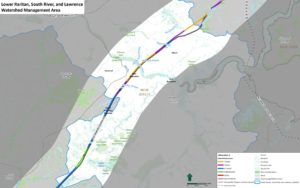
NEC Future Alternative 3, Lower Raritan Watershed. Image: AECOM
Alternative 1 maintains the role of rail as it is today, keeping pace w/ demographic change.
Alternative 2 grows the role of rail with service to new markets and more frequent intercity and regional trains looking at connecting markets. In central NJ Alternative 2 proposes a new rail segment that begins in North Brunswick and runs parallel to the NEC all the way to Seacaucus. This new segment includes creation of a tunnel running underneath the Raritan River between New Brunswick and Highland Park through to Metuchen and Edison.
Alternative 3 builds on Alternative 2 to transform the role of rail in the region with a second spine supporting faster trips and service to new markets, including an extension through North Brunswick.
AECOM is currently conducting Environmental Impact Statements (EIS) for each alternative, and plans to announce the preferred alternative in summer 2016 with Servive Development Plan exercises to being in 2017.
After Mr. Gargan’s very informative presentation, Nick Tufaro spoke about Middlesex County’s involvement with NJTransit and Together North Jersey’s “Planning Transit Friendly Places” projects. Planning Transit Friendly Places centers on Transit Oriented Development ((TOD) which, by its very nature, requires active collaboration among elected officials, transit planners, housing department professionals, private developers, philanthropic, leaders, community development financial institutions, and community advocates. Land use and transportation plays a vital role in nearly all other aspects of a community, like housing, business environment, energy and climate, and health and safety, so it is important to plan these transit friendly places to improve upon the community as a whole.
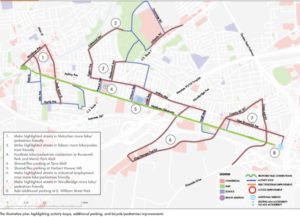
Middlesex Greenway Action Plan. Image: Middlesex County Office of Planning
Mr. Tufaro highlighted examples of Transit Oriented Development throughout the Lower Raritan Watershed, including the Middlesex Greenway Extension and Middlesex Greenway Access Plan, a large project that involves conversion of a former rail line into many miles of bicycle trails and park space for public use. Perth Amboy’s Bay City Transit District Strategy focused around the train station on Smith Street, and the Woodbridge-Rahway Regional Access to the Arts project. Other notable mobility and recreation assets projects in the Lower Raritan Watershed include the Raritan Riverwalk Trail in Perth Amboy, the Helmetta Pond Palling Trail, the Capik Nature Preserve Trail in Sayreville, and the Highland Park Meadows Trail. The LRWP is organizing field trips to several of these sites this year – please plan to join us for our first such outing – a picnic and tour of the Highland Park Meadows on June 2!

















